Japan
Wood Products Prices
Dollar Exchange Rates of 25th
May
2023
Japan Yen 138.20
Reports From Japan
Consumers are spending again
The Cabinet Office has reported the economy grew by an annualised
1.6% in the first quarter of 2023 as consumers were spending again. Spending
increased in the service sector, including travel and dining and sales of
new cars were strong. Consumer spending accounts for more than half of
Japan's GDP. However, exports in the first quarter were weak.
An economy growing faster than expected, despite a global downturn, may
encourage the new Bank of Japan governor, Kazuo Ueda, to adjust the Bank
policy even before the review he called for is completed.
See:
https://www.japantimes.co.jp/news/2023/05/17/business/japan-economy-grows-more-technical-recession/
First quarter machinery orders disappoint
The total value of machinery orders received by 280 major
manufacturers operating in Japan increased by 2.5% in March from the
previous month on a seasonally adjusted basis. In the January-March period
it decreased by 9.7% compared with the previous quarter.
Private-sector machinery orders (excluding volatile ones for ships and those
from electric power companies) increased a seasonally adjusted by 7% in
March but decreased by 3.6% in January-March period.
In the April-June period the total machinery orders has been forecasted to
increase by 5.2% but private-sector orders, excluding volatile ones, were
forecast to fall by 8% from the previous quarter.
See:https://www.esri.cao.go.jp/en/stat/juchu/2022/2203juchu-e.html
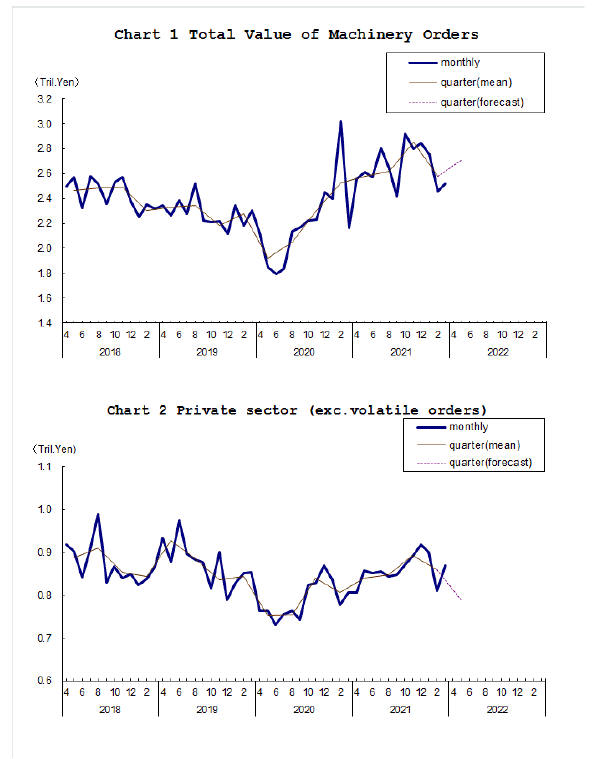
Electricity price hike will drive up
manufacturing costs
The government has approved sharp increases in electricity prices
by Japan’s major power companies effective June. Price increases will be
between 14% and 42%. This will disappoint households already experiencing
inflation rates not seen for decades. The increase in electricity charges
will raise inflation by almost half a percent according to an economist at
Nomura Research Institute.
Throughout the world electricity prices have been rising since Russia
invaded Ukraine and disrupted energy markets.
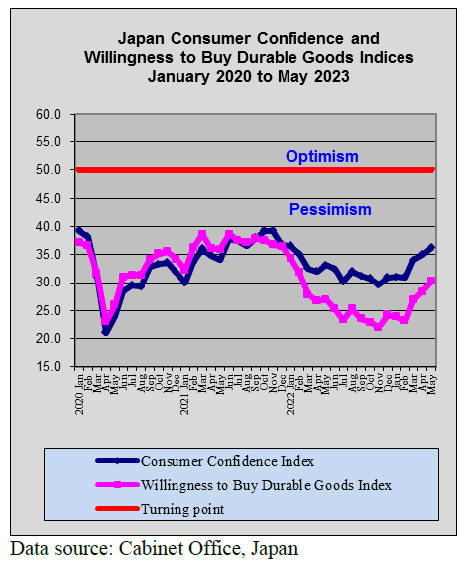
Accelerated inflation impacts exchange rate
Japanese Yen exchange rate has been influenced by Japan’s inflation
data which pointed to a continued upward trend.
In April Japan’s inflation re-accelerated after slowing earlier in the year.
This will be of concern to the BoJ as it may mean the Bank has to revise its
price outlook.
See:
https://www.fxstreet.com/news/usd-jpy-gathers-strength-to-print-fresh-five-month-high-above-13800-ahead-of-japans-inflation-202305180040

Changing demographics – declining demand for
new homes
The worldfolio.com website carries an informative interview with
the head of a major construction company which will interest wood product
exporters. Commenting on the challenges and opportunities from the
demographic changes occurring in Japan the executive said that, in a very
short time, one in three Japanese people will be over the age of 65 which
will result in two challenges; the problem of finding skilled workers and a
declining domestic market for new homes.
One of the effects of Japan's demographic situation is that demand for new
construction is decreasing, however, the executive said his company is
seeing an increase in demand for the maintenance and repair.
See:
https://www.theworldfolio.com/interviews/wings-aims-to-spread-the-japanese-way-of-wood-in-housing/5674/
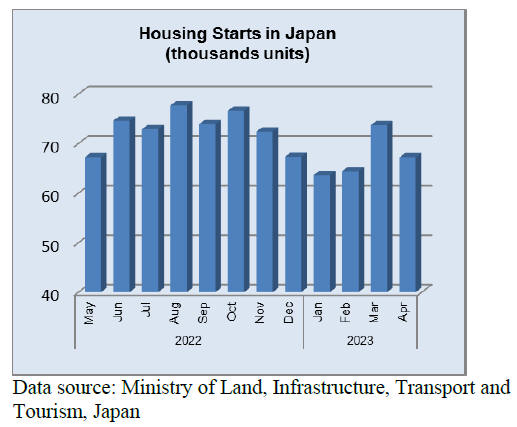
Import update
Over the past five years there has been a very noticeable
and steady rise in the value of Japan’s imports of wooden
bedroom furniture in contrast to the trends in import
values for wooden office and kitchen furniture. The steady
increase in the value of bedroom furniture cannot be
explained onlyby the impact of rising FOB prices in
supply countries or with impact of exchange rates.
See:
https://www.nippon.com/en/news/yjj2023050901086/
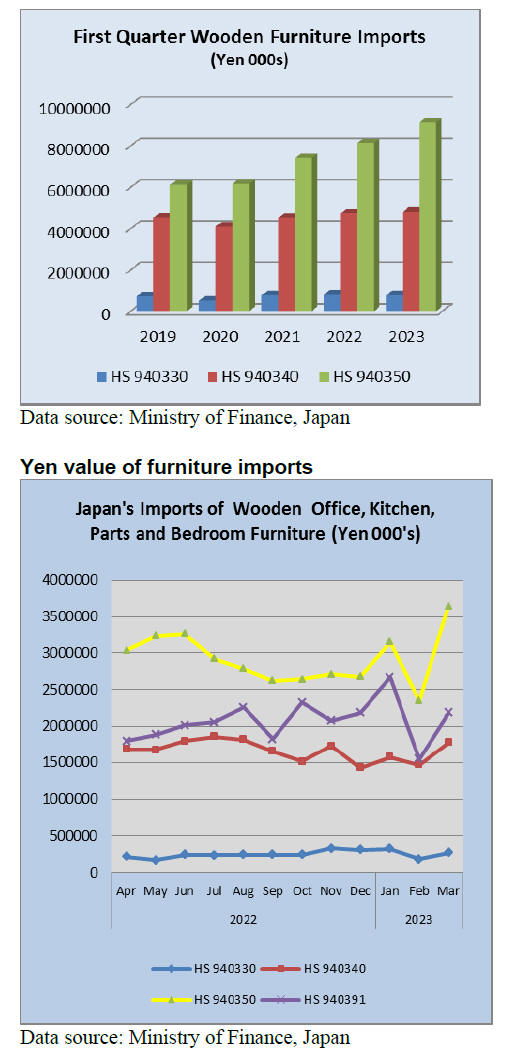
It can be seen in the graphic abovew that the
upswing in
the value of imports of bedroom furniture began in 2021
despite the Covid restrictions and depressed consumer
spending. One possible explanation could be that those
having to work from home had to rearrange bedrooms to
make space for a home office.
Throughout 2022 the comsumer sentiment and the
willingness to buy durable goods indices in Japan were in
neagitive territory and this depressed purchases of
furniture.
In May the Japanese furniture retailer Nitori Holdings
reported its 2022 annual returns which showed the first
decline in profits in 24 years. The main reason cited for
the poor profits was the higher cost of imported products
due to the weak yen and high ocean transportation costs.
March 2023 wooden office furniture imports (HS
940330)
February shipments of wooden office furniture from China
were lower than in the previous few months because of
factory closures over the Chinese New Year. The value of
Japan’s wooden office furniture (HS940330) imports from
China almost double in March compared to a month
earlier firmly establishing shippers in China as the top
supplier accounting for 87% of Japan’s wooden office
furniture in March.
Year on year the value of wooden office furniture imports
in March increased as they did compared to a month
earlier. In March the second and third ranked suppliers in
terms of the value of imports were Poland and the USA
with each accounting for around just 2% of the total value
of March imports.
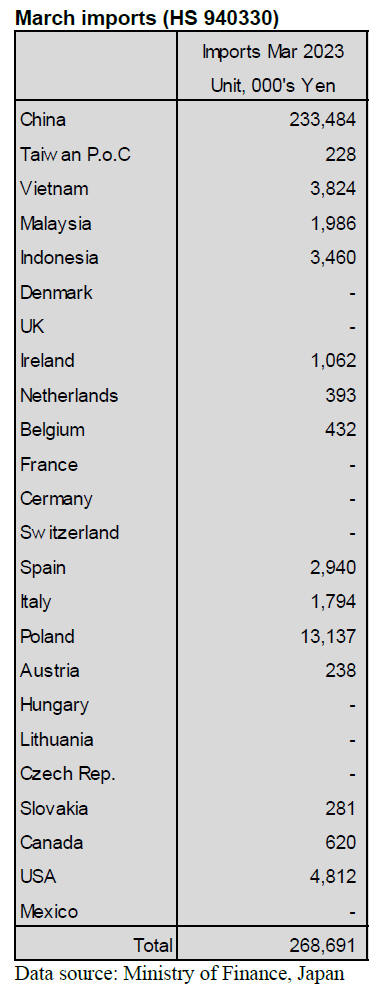
March 2023 kitchen furniture imports (HS
940340)
The Philippines and Vietnam maintained their positions as
the top suppliers of wooden kitchen furniture (HS 940340)
to Japan in March.
Shipments from manufacturers in the Philippines
accounted for 43% of March arrivals while shipments
from shippers in Vietnam accounted for 38% of March
arrrivals, almost double that of February shipments.
Exorters in China and Thailand accounted for around 5%
each of March shipments bringing the total for the top four
shippers to 87% of March arrivals.
Year on year the value of Japan’s March imports of
wooden kitchen furniture rose from a month earlier and
the same trend was seen in month on month imports.
Rising input costs and higher prices in supply countries
and the weak yen had an impact on the total value of
imports.
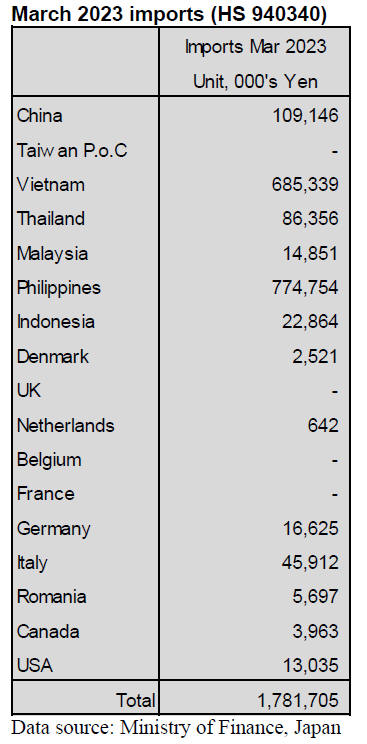
February 2023 wooden bedroom furniture
imports (HS
940350)
In February there was a massive downward correction in
the value of shipments of wooden bedroom furniture as in
each of the main supply countries, China and Vietnam
there were extended holidays in the month. The value of
March arrivals of wooden bedroom furniture (HS 940350)
more than made up for the decline reported for February in
fact in March there was a 55% rise in the value of imports
lifting the monthly value well above the average for the
previous 12 months.
Much of the increase in the value of shipments is because
of higher FOB prices reflecting increased production costs
and the impact of the weak yen.
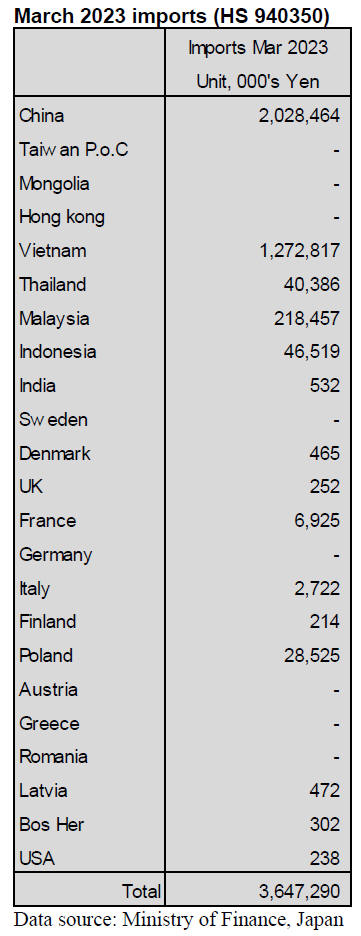
March 2023 wooden furniture parts imports
(HS 940391)
After the decline in the value of February imports, the
value for March restored the value of monthly imports
back only to the average for the past 12 months. This was
unexpected as the impact of higher FOB prices and the
weak yen was a factor in the rising import values for
office, kitchen and bedroom furniture.
Shipments of wooden furniture parts from China in March
were almost double that in February as factories resumed
full time operation. There was also a sharp rise in month
on month shipments from Vietnam. Indonesia and
Malaysia were the other two shippers of note in March.
The March value of Japan’s imports of wooden furniture
parts was little changed from that in March 2022 but,
compared to February, there was an over 40% rise in the
value of imports.

Trade news from the Japan Lumber Reports (JLR)
The Japan Lumber Reports (JLR), a subscription trade
journal published every two weeks in English, is
generously allowing the ITTO Tropical Timber Market
Report to reproduce news on the Japanese market
precisely as it appears in the JLR.
For the JLR report please see:
https://jfpj.jp/japan_lumber_reports/
LVL made of domestic larch
Key Tec Co., Ltd. will expand selling high strength
structural LVL. The company used to produce the high
strength LVL by Russian logs or Russian veneers but the
company reduced producing and selling the high strength
structural LVL due to banned importing Russian logs and
Russian veneers.
Domestic larch will be used for the product this time. It is
able to order the high strength structural LVL by other
materials such as Douglas fir or radiata pine. Product of
high strength structural LVL made of Russian larch was
about 50,000 cbms annually before the invasion in
Ukraine by Russia. Then, the product declined to 35,000
cbms. Now, the company produces the high strength
structural LVL by domestic larch for 6,000 cbms in a year
and will raise to 10,000 cbms.
Domestic softwood plywood
Movement of domestic softwood plywood will be bearish
in May. Distribution companies start to procure materials
because the inventory clearance at the end-of-term setting
of accounts is over. However, shipment is on the road to
recover. Some plywood companies lower the price if they
got a large number of orders from clients.
Inventory of plywood is less than before because the
shipment has been exceeding product since March. The
price of 12mm 3 x 6 structural softwood plywood is 1,800
– 1,850 yen, delivered per sheet and this is about 50 yen
lower than the previous month. The price for a large
number of orders is around 1,700 yen.
Orders to the precutting plants have been increasing since
February, 2023 but consumers still purchase only for the
present use. One of the reasons is anticipation of falling
prices. Plywood manufacturers take time to control the
inventory because there are not enough inquires yet.
However, demand and supply are recovering slightly for
sure because the inventory of structural softwood plywood
at the end of March is 147,383 cbms and this is 1.7%
down from February, 2023. This is for the first time
decreasing in nine months. Product is 173,907 cbms and
this is 5.8% up from the previous month. Shipment is
176,425 and this is 9.2% up from the previous month.
The inventory in May would be less than April’s inventory
because there was a big holiday at the end of April through
May.
If the inventory continued decreasing, consumers would
buy more plywood in a hurry. Then, the plywood
manufacturers would be able to stop lowering the price.
This is what the plywood manufacture were planning for.
South Sea logs and lumber
Inquiries for South Sea lumber are better than before.
However, there are less inquiries from Japanese plywood
manufacturers because of sluggish movement of imported
South Sea plywood.
Therefore, there are not enough South Sea Logs and
it is difficult to get South Sea logs for lumber. It takes a lot of time to
get lumber for the deck or for the body of trucks. There are less inquiries
for laminated fixture lumber because the yen fell to 130 yen against the
dollar.
Indonesian sellers are not positive to get a lot of orders for Merkusii pine
lumber by lowering the price. The reasons are that it is a strong Rupiah
against the dollar now and it is a season for fresh Merkusii pine logs so it
is difficult to buy low-priced Merkusii pine logs.
There are not many inquiries for Chinese red pine lumber and product is low.
Chinese sellers would not lower the price because the electricity rates and
the production costs are rising.
Japan established a law of green transformation
The Japanese Parliament enacted a bill for promoting so-called
green transformation to drive a transition to a carbon-neutral society. The
government will issue 20 trillion yen in 10 years from fiscal 2023. The
government will promote to support decarbonization and energy saving in
public transportation, distribution industry and housing / structure
industry.
The Ministry of Land, Infrastructure, Transport and Tourism will change the
social system of any business related to green transformation. For housing
industry, all houses and non-housing buildings must be ZEH (Net Zero Energy
House) or ZEB (Net Zero Energy Building).
Radiata pine logs and lumber
The price of Chilean radiata pine lumber in Japan has been weak
since spring of this year. In the Greater Tokyo Metropolitan area, the price
of Chilean radiata pine lumber was lowered by around maximum 3,500 yen, FOB
per cbm in April.
Then, the price was 58,500 – 60,500 yen, FOB per cbm for thin boards and was
56,600 – 58,500 yen, FOB per cbm for squares. One of the reasons is that the
lumber shipped to Japan in November, 2022 arrived and the price was $50, FOB
per cbm lower than the previous time at that time in Chile. Japanese
wholesalers will also lower the price by maximum 3,500 yen, FOB per cbm in
May.
The price of lumber shipped to Japan in April is US$350, CIF per cbm and
this is US$10, FOB per cbm higher than last time. The lumber will arrive to
Japan in the middle of June because the vessel was delayed by Chilean
shippers due to the inventory in Japan.
New Zealand logs for Japan cost US$150- 160, C&F per cbm and this is
stabilized from last time. The price of NZ lumber in Japan is 62,000 –
64,000 yen, per cbm and this is leveled off from the previous time. Some
reasons are that electricity charges and cost of antifungal agent are
rising.
The price of Vietnamese plywood for crating in Japan is 1,150 yen, delivered
per sheet. The size is 8.5mm, 4 x 8. The price is 50 yen, per cbm down from
last month.
|